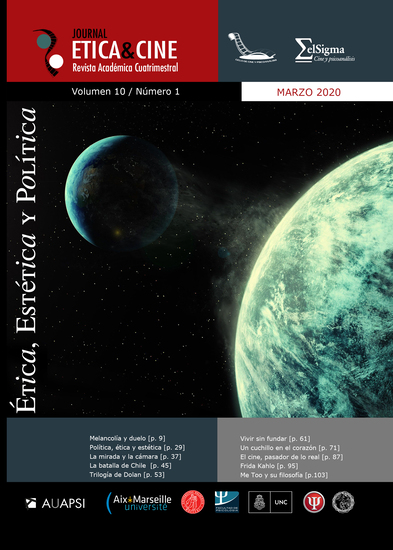The gaze by the camera / Cinema, puberty scenes and juvenile sexual theories
DOI:
https://doi.org/10.31056/2250.5415.v10.n1.29209Keywords:
Gaze by the camera, Puberal scenes, Blazons, Juvenile sexual theoriesAbstract
The article unveils an analytical clinical sequence with Olga, a teenager associating in a session around a scene from the film Freaks by T.
Browning. The text articulates the concepts of look at the camera (Vernet) and gaze by the camera (Bonnet) as giving particular account in the
course of the treatment of the construction of scenes, even adolescent fantasies. Olga describes in turn the gaze of a character from the film, at
the same time as she deploys her gaze in the space of the session and offering herself to the analyst’s gaze with the sign of a wound on her body.
This wound constitutes her like a heroine with a scar, that is to say, a carrier of a sign, a mark, even a Blazon of the female body. The conception of pubertal scenes (Gutton) and Blazons of the adolescent body (Bonnet), will be put in tension with the logic of the gaze by the camera in
order to better approach the logic of juvenile sexual theories. We argue that beyond Freud’s three infantile sexual theories, it becomes necessary
in adolescent clinical analytics to forge extensions, redesigns and creations of original sexual theories. At the confluence of the infantile and
the juvenile, we are trying to formalize the place of the genital in the field of puberty. Our proposal organizes three juvenile sexual theories:
first the theory of the genital Blazons, then a theory of the embrace of the hero with the scar; finally a theory of the hero’s test against the horde.
The originality of these three juvenile sexual theories is due to the formal structure that gives them to be heard in the discourse of adolescents.
So in the knotting between gaze by the camera and juvenile sexual theories appear in the transference the conditions of a construction of the
genre in adolescence.
Downloads
References
Arasse, D. (1982). Frances Yates et les labyrinthes occultes de l’histoire. Débat, 22, 41-48.
Arasse, D. (1992). Le détail, pour une histoire rapprochée de la peinture. París: Flammarion [trad. esp.: (2008). El detalle, para una historia cercana de la pintura, traducción de Paloma Ovejero. Madrid: Abada].
Arasse, D. (2000). On n’y voit rien. Descriptions. París: Denoël.
Barthes, R. (1966). Introduction à l’analyse structurale des récits. Communications, 8. Barthes, R. (1981). L’analyse structurale durécit. París: Seuil [trad. esp.: Barthes, R. y otros (1972). Análisis estructural del relato. Buenos Aires: Editorial Tiempo Contemporáneo].
Bonnet, C.; Pechikoff, S. (2007). Guenièvre en ses blasons. Adolescence, 60, 341-346.
Bonnet, C.; Pechikoff, S. (2011). Roman adolescent et scènes pubertaires. Adolescence, 78, 787-800.
Bonnet, C.; Petit, L.; Pasquier, A. (2014a). Portrait de l’adolescent en héros à la cicatrice. Psychologie clinique, 38, 45-54.
Bonnet, C.; Pechikoff, S.; Petit, L. (2014b). De l’exposition du héros aux blasons du corps adolescent. Topique, 126, 25-38.
Bonnet, C. (2018). L’œil de la caméra et la rhétorique de l’image. Ética y Cine Journal, 8, 2 [trad. esp.: “El ojo de la cámara y la retórica de la imagen”, traducción de Noelia Luzar, Ética y Cine Journal, 8, 2].
Browning, T. (productor y director). (1932). Freaks [cinta cinematográfica]. Estados Unidos: Metro-Goldwyn-Mayer
Foucault, M. (1996). L’arrière fable. En Dits et écrits. París: Gallimard [trad. esp.: (2005). La trasfábula. En De lenguaje y literatura, traducción de Isidro Herrera. Barcelona: Paidós].
Foucault, M. (1966). Les mots et les choses. París: Gallimard [trad. esp.: (1968). Las palabras y las cosas, traducción de Elsa Cecilia Frost. Buenos Aires: Siglo XXI].
Freud, S. (1905, 1962), Trois essais sur la théorie sexuelle. París: Gallimard [trad. esp.: (2005). Tres ensayos de teoría sexual. En Obras Completas, traducción de José Luis Echeverry. Buenos Aires: Amorrortu, t. VII].
Gutton, P. (1991). Le pubertaire. París: PUF [trad. esp.: (1993). Lo puberal. Buenos Aires: Paidós].
Gutton, P. (1996). Adolescens. París: PUF.
Lévi -Strauss, C. (1958). Anthropologie structurale. París: Gallimard [trad. esp.: (1959). Antropología estructural. Buenos Aires: Siglo XXI].
Vernet, M. (1983). Le regard à la caméra. Iris, 2.
Yates, F. (1975). L’art de la mémoire. París: Gallimard [trad. esp.: (2005). El arte de la memoria, traducción de Ignacio Gómez de Liaño. Madrid: Siruela].
Downloads
Published
How to Cite
Issue
Section
License
Copyright (c) 2020 Ética y Cine

This work is licensed under a Creative Commons Attribution-ShareAlike 4.0 International License.
Los autores que publiquen en Ética y Cine Journal aceptan las siguientes condiciones:
Los autores/as conservan los derechos de autor © y permiten la publicación a Ética y Cine Journal, bajo licencia CC BY-SA / Reconocimiento - Reconocimiento-CompartirIgual 4.0 Internacional. La adopción de esta licencia permite copiar, redistribuir, comunicar públicamente la obra, reconociendo los créditos de la misma, y construir sobre el material publicado, debiendo otorgar el crédito apropiado a través de un enlace a la licencia e indicando si se realizaron cambios.

Este obra está bajo una licencia de Creative Commons Reconocimiento-CompartirIgual 4.0 Internacional.




